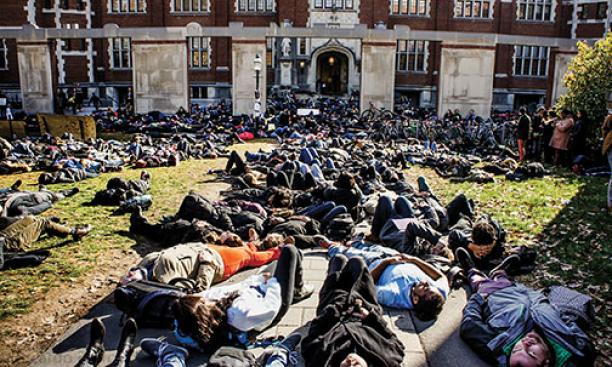

In the wake of student protests following the decisions not to indict police officers in the deaths of unarmed black men in New York and Ferguson, Mo., President Eisgruber ’83 announced a new effort to strengthen the University’s policies and practices “regarding diversity, inclusion, and equity on campus.”
At a Dec. 8 meeting of the Council of the Princeton University Community (CPUC), Eisgruber asked the CPUC’s executive committee to recommend ways to enhance the University’s policies and to provide opportunities to discuss national events. “Princeton has a responsibility to bring its scholarship and teaching to bear on these urgent problems,” he said.
About 150 students attended the CPUC meeting, and during a 90-minute discussion, several pressed for quick action on diversity-related issues. “A lot of us have been having conversations since we set foot on this campus, and right now we are very upset — we’re angry, and we want action,” Achille Tenkiang ’17 said.
“We’re having this conversation because we know we can do better,” Eisgruber said. “The measures that we take that are going to make a difference are measures that are well thought-through and measures that have the support of the community behind them, and not just a set of people in this room ... a collective decision by the University to do things differently than it has done.”
The CPUC meeting took place a day after the Undergraduate Student Government called on the University to establish concentrations in African American studies and in Latino studies, hire more faculty members of diverse identities and backgrounds, and implement mandatory training in effective interaction with people of different cultures for all University employees.
Eisgruber said a training program would have to be voted in place by the faculty before it could be established as mandatory for professors, but that he and his cabinet already had decided to take part in such training. Asked about a concentration in African American studies, he said this would require faculty and trustee approval. When the Center for African American Studies was created, he said, it was envisioned that “there might well come a time when the center would make a proposal for either the creation of a concentration or a department or both.”
Students handed out fliers listing suggested changes to the University policies that the students said “promote a campus culture acceptant of racial animus and insensitivity.” Their recommendations focused on three areas: transparency, awareness, and support. The CPUC executive committee met later in the week and created working groups to address each of those broad areas, promising a “comprehensive report” by May 2015.
The actions came after two campus protests. Several hundred students walked out of classes Dec. 4 to take part in a “die-in” outside Frist Campus Center to protest the decision by a grand jury not to indict a New York police officer in the death of Eric Garner. A week earlier, students had held a late-night demonstration along Prospect Avenue to protest the decision of a grand jury in Ferguson, Mo., not to charge a police officer in the death of Michael Brown.
